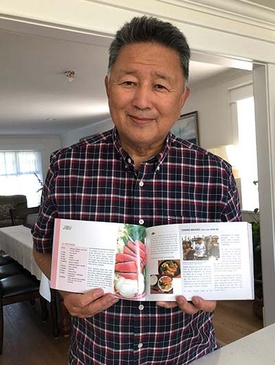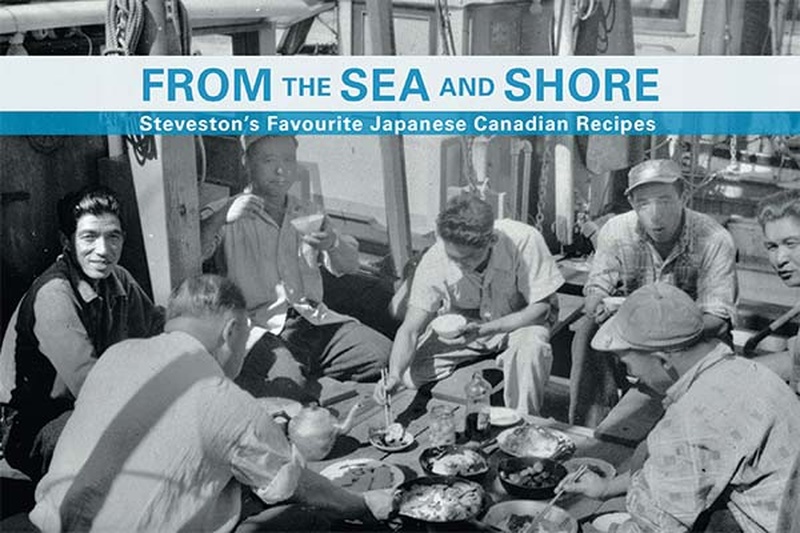STEVESTON — Inspiration struck for the community cookbook, From the Sea and Shore: Steveston’s Favourite Japanese Canadian Recipes, from the monthly Nikkei seniors’ luncheons at the Steveston Japanese Canadian Cultural Centre (SJCCC). The luncheons were a way for Japanese Canadian seniors to connect and reminisce with old friends over a home-cooked Japanese Canadian meal.
Volunteers would cook Japanese Canadian comfort foods like kabocha, teriyaki salmon, and okayu. As the seniors’ Sansei children arrived to drive them home, the smells drifting out of the kitchen would transport them back to their youths and their parents’ home cooking.
“They would say, ‘oh, I remember having that,’ or ‘oh, I wish I could have that,’ and people would ask for the recipes,” Kelvin Higo, who organized the book, tells Nikkei Voice in an interview.
Higo, 71, grew up in Steveston, next to the Brittania Shipyards, in an enclave of homes owned by the BC Packers. He is a longtime volunteer with Steveston Community Society, Steveston Kendo Club, and chairman of the Wisteria Place Seniors independent living facility.
With his wife Kay, often one of the volunteers cooking the seniors’ luncheon, the idea began to create a cookbook based on the recipes that define Steveston’s Japanese Canadian community and to preserve them for future generations. Since printing in October, Higo was overwhelmed by the support and response to the book and has just ordered its second printing.
“The most powerful feedback I got from someone was an email said, ‘this tastes like memories,’ and I thought that was the best compliment that we received,” says Higo.

Higo wanted to create a cookbook that would evoke memories of the Steveston Japanese Canadian community through its food. The book is a culmination of 65 recipes collected from Japanese Canadian community members in Steveston. Paired with the recipes are anecdotes and stories about the food and the people who cooked them.
At the turn of the 20th century, over 4,000 fishermen lived in B.C. Located on the Fraser River, the prewar village of Steveston was the centre of the fishing industry, with salmon canneries lining the waterfront. The community’s recipes reflect their deep connection to the sea as a source of income and sustenance.
Today, sushi restaurants outnumber fast-food restaurants on the Lower Mainland, but their menus do not reflect the food found in this cookbook. The Japanese Canadian recipes that fill these pages reflect the history of the community in Steveston. They are early recipes brought by the Issei from Japan and adapted to accommodate the local ingredients, favourite recipes from annual festivals, and recipes that reflect the fusion of cultures in Steveston, like chow mein and pakkui (sweet and sour pork).
Recipes unfold season by season and tell the story of Steveston through the fishermen’s eyes. Recipes reflect what the fishing families would eat throughout the year, relying on what was in season in the sea for protein and to harvest on the shore.
“We used to always look forward to the first spring salmon because Fraser River fish tastes differently than fish from other rivers and up the coast,” says Higo.
The book was a partnership between the SJCCC and Tonari Gumi, the Japanese Volunteer Association. Tonari Gumi previously published two community cookbooks, Home Away from Home and Our Edible Roots. Higo reached out to David Iwaasa, Tonari Gumi’s executive director at the time and current board chair, for advice and realized a partnership between the two organizations with deep roots in the community would be ideal.
Iwaasa introduced Higo to Miki Miyano, the graphic artist for Tonari Gumi’s two previous books and a publisher in Winnipeg. Also crucially, Iwaasa helped Higo successfully apply for funding through a New Horizons grant. The book began to take shape as a “memory cookbook.” Instead of just recipes, the book focuses on collecting and sharing memories from community seniors, explains Higo.
Higo was the photographer, interviewer, and researcher for the book. He also wrote many of the stories within. His cousin Louise Yako was the volunteer book editor, reviewing each story and recipe for clarity and consistency. Kay was the recipe tester, cooking most of the recipes to ensure they were accurate and produced the food promised. Higo’s 100-year-old father-in-law, Toshio, was living with them at the time and would taste test all of the recipes. The book shares a story about Toshio and the jibu (hot pot) he used to cook on his fishing boat.
“Fortunately, at the time, my father-in-law had moved in with us, and he would test out the recipes for us. The bad thing was, he liked all food, so we weren’t always sure we got an honest opinion. But he thoroughly enjoyed the food,” says Higo.
For many, food is a connector to community, heritage, and culture, explains Higo. After April of 1949, when wartime restrictions finally lifted against Japanese Canadians, 250 fishermen and their families returned to Steveston. When Higo was growing up in Steveston after the war, there were very few Japanese restaurants, and it was expensive for families who were just starting to rebuild their lives to eat out. Instead, community events were where people ate Japanese food.
“You had to go out and enjoy your Japanese food at community events like the Steveston Buddhist temple bazaars. They would have the spring and fall bazaar, and they would sell futomaki and agezushi and things like that,” says Higo. “It’s those types of activities that bring the community together. We have a variety of cultural organizations, from the martial arts group to the language school, to the odori dance groups to the Buddhist temple and United Church, they all contribute to that food culture here in Steveston.”
Like many of the memories that revolve around community events and food, it is often the mothers, grandmothers, and great-grandmothers who were the backbone of these events, working behind the scenes and making the food, says Higo. Because of that, this book is dedicated to the Japanese Canadian women who persevered and overcame hardship and challenges to provide food, comfort, and safety to their families.
“Food was always prepared by the women. When the men were on the ocean, they had to cook for themselves, otherwise, they didn’t eat, but when they were at home, it was always the women,” says Higo.
As set out in the book’s foreword by Masako Fukawa, food is a bridge that can connect generations. Food evokes pleasant memories and is often how culture and heritage unique to the Japanese Canadian community pass through generations.
“Food is that generational connector, and I think we’re just at a cusp of losing this community knowledge. I think this project has contributed in some way to maintaining that connection between generations,” says Higo.
Part of the outputs of the New Horizons grant was to pair the book with cooking classes, so this cultural knowledge passes through generations. In two Zoom classes, Kay taught enthusiastic groups how to cook chow mein and then egg foo young with its leftovers, as well as sunomono. They hope eventually to have in-person classes to teach how to make manju and other precious community recipes.
Higo hopes Japanese Canadian families will make these recipes their own. Like each of his wife’s cookbooks that are earmarked and filled with additions and tweaks in the margins, he hopes others will adapt these recipes to taste like what their own families made.
“Everybody has their own family’s way of doing things. The recipes we provide is like an averaging of all the [recipes we collected], and when we cooked it and tasted it, we tried to average the taste that people were familiar with,” he says. “We’re hoping that most of these recipes will create those memories for yourself and bring back those memories.”
* * * * *
FROM THE SEA AND SHORE: JIBU
A favourite recipe from the Steveston community is jibu, a salmon hot pot dish that Japanese Canadian fishermen would cook on their boats. Often enjoyed as a pot luck meal, the fishermen would each contribute different ingredients to add to the pot, says Kelvin Higo.
Most important, fresh salmon!
Here is the recipe for jibu, shared from the community cookbook From the Sea and Shore: Steveston’s Favourite Japanese Canadian Recipes.
Makes 4 to 6 servings.
Ingredients:
2 lbs salmon fillets, cut into ½-inch slices
1 cup soy sauce
1 cup sugar
1 cup water
1/4 cup mirin or sake
1 bunch green onions
1 medium onion, sliced
1 block tofu, cubed
1 bunch spinach
2 cups snow peas
3 cups hakusai or cabbage, chopped
6 stalks fuki, peeled, par-boiled and cut into 2-inch lengths
Directions:
In a large frying pan or other wide, shallow pan, combine the soy sauce, sugar, water, mirin or sake and heat until the sugar has dissolved. Add the salmon fillets and remove them when cooked.
After setting aside the fish, return the broth to a boil, add the onions, hakusai, snow peas, and fuki. After a few minutes, add the remaining vegetables and tofu to the broth. Simmer about 5 more minutes. Return the fish to the pan to warm before serving.
* * * * *
From the Sea and Shore: Steveston’s Favourite Japanese Canadian Recipes is available for $20 from Tonari Gumi, the Gulf of Georgia Cannery, the Sunshine Tashme Museum, and Nikkei National Museum, which offers nationwide shipping (shop.nikkeiplace.org).
*This article was originally published in the Nikkei Voice on February 15, 2022.
© 2022 Kelly Fleck/Nikkei Voice







